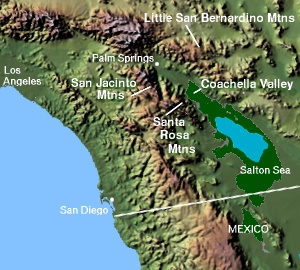Santa Rosa Mountains (California)
| Santa Rosa Mountains | |
|---|---|
|
Topographic map of the Santa Rosa Mountains and neighboring mountains |
|
|
Homes of Indians |
|
| Highest peak | Toro Peak ( 2657 m ) |
| location | Riverside County , San Diego County, and Imperial County in California , United States |
| part of | Peninsular Ranges |
| Coordinates | 33 ° 31 ′ N , 116 ° 25 ′ W |
| Type | mountain range |
The Santa Rosa Mountains are a mountain range in the Peninsular Ranges , east of the Los Angeles Basin and northeast of the metropolitan area of San Diego in southern California in the southwestern United States .
geography
The mountain range extends for approximately 30 miles on the west side of the Coachella Valley in the Riverside , San Diego and Imperial Counties in southern California . At the northern end of the Santa Rosa Mountains is the border with the San Jacinto Mountains , which is marked by California State Route 74 .
At 2657 m, Toro Peak is the highest mountain within the mountain range. It is located about 35 km south of Palm Springs on State Route 74 and on the northeast side of Upper Coyote Canyon in Anza-Borrego Desert State Park . As part of the North American continental divide , the Santa Rosa Mountains separate the Salton Depression with the Salton Sea from the Pacific Ocean .
history
The southeastern reaches of the Santa Rosa Mountains were first seen by non-residents in 1774 when a Spanish expedition led by Juan Bautista de Anza from New Spain reached the Coachella Valley and the historic California landscape . Maps from the 19th century show the Santa Rosa Mountains as the southern extension of the San Jacinto Mountains . The name "Santa Rosa Mountains" did not come into use until 1901 by the United States Geological Survey .
nature
The lower lying areas of the Santa Rosa Mountains belong to the ecoregion of the Colorado desert , the higher lying areas to the chaparral and the mountain forests of California. Chaparral occurs particularly on the eastern rain shadow side of the mountains. Also in the east of the mountains, the native and endangered California Washington palm ( Washingtonia filifera ) can be found in canyons with natural oases . Another critically endangered species in the Santa Rosa Mountains is the Peninsular bighorn sheep ( Ovis canadensis cremnobates ), which is endemic to the Peninsular Ranges .
Protected areas
Most of the northern Santa Rosa Mountains in Riverside County are part of the Santa Rosa and San Jacinto Mountains National Monument . It was created in 2000 and is jointly administered by the Bureau of Land Management and the United States Forest Service in the San Bernardino National Forest . The southern part of the Santa Rosa Mountains with the highest peak called Toro Peak is protected by the extensive Anza-Borrego Desert State Park . Both sanctuaries have visitor centers, starting points for hikes, and many hiking trails that cover all elevations in the Santa Rosa Mountains. In 1990 the California State Legislature approved the formation of the Coachella Valley Mountains Conservancy to protect this and other mountain ranges around the Coachella Valley .

